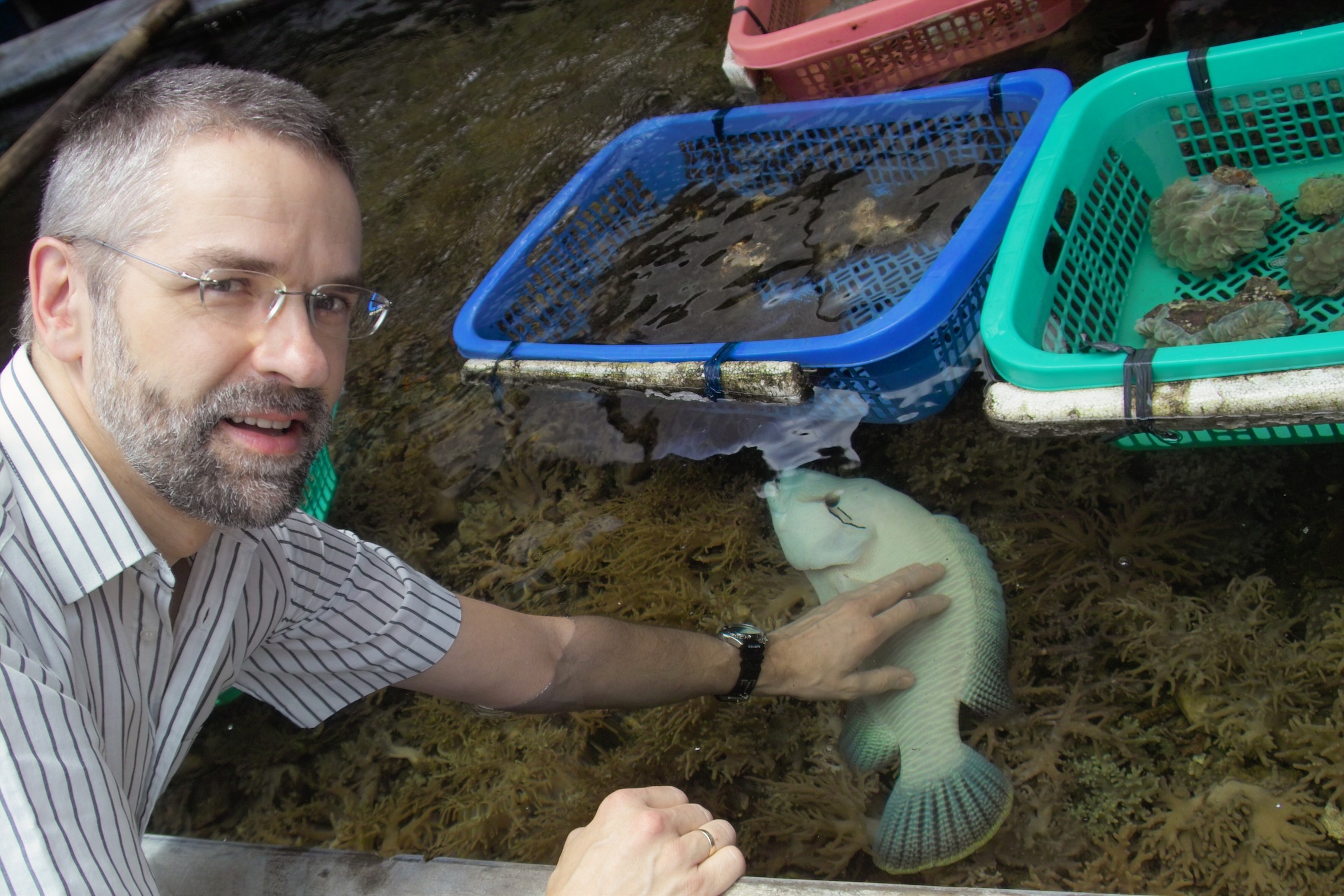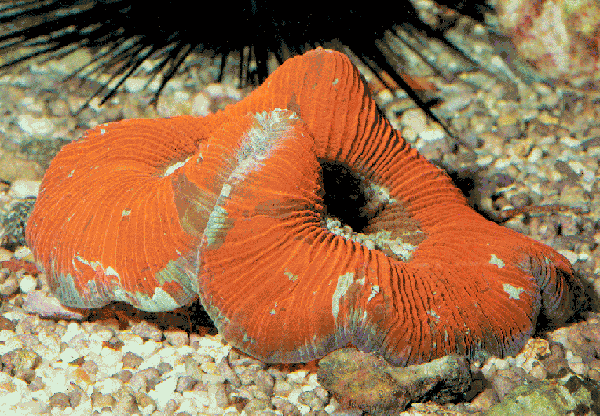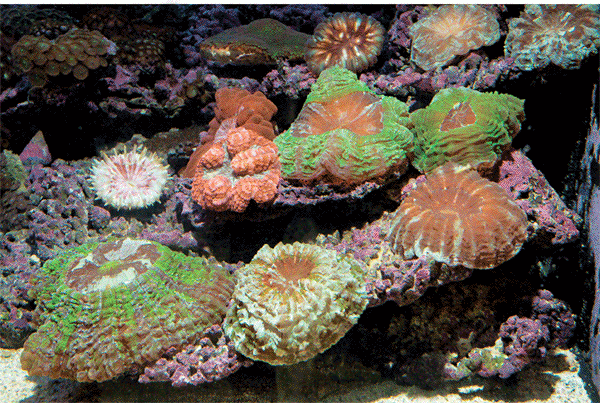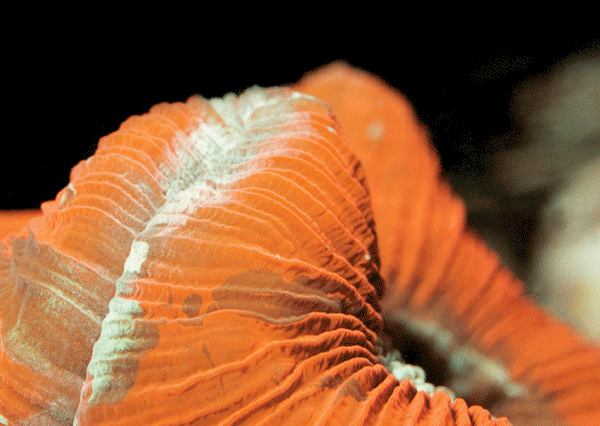|
Daniel Knop on LPS Corals
International Editor of CORAL Magazine Discusses LPS Corals  The March / April issue of the English language edition of CORAL Magazine features large-polyp stony (LPS) corals, and the magazine’s international editor, Daniel Knop, has authored three of the features on this very popular category of corals. Daniel, the author of 22 books, is undoubtedly an expert when it comes to LPS corals, and so we thought it might be valuable to interview him on the subject for Blue Zoo News readers. The March / April issue of the English language edition of CORAL Magazine features large-polyp stony (LPS) corals, and the magazine’s international editor, Daniel Knop, has authored three of the features on this very popular category of corals. Daniel, the author of 22 books, is undoubtedly an expert when it comes to LPS corals, and so we thought it might be valuable to interview him on the subject for Blue Zoo News readers.
Passionate about coral both in the aquarium and on natural reefs, Knop is a leader in reef conservation and an avid supporter of coral farming. An accomplished underwater photographer, his images can be seen in books and magazines, on websites and even on marine aquarium products the world over. He is one of the few contemporary marine aquarium writers to actually have a coral genus named after him (Knopia)! We are honored he was willing to sit down for a few moments with Blue Zoo News to discuss LPS corals.
BZN: Thank you so much for taking the time to sit down and speak with us about LPS coral. Of course we’d love to encourage people to subscribe to the magazine, so we won’t try to distill your three excellent articles into a single interview, but we are hoping to get some insight from you on this very popular (if not very precise) category of aquarium corals. Let’s start with the term itself. In your “Letter from Europe”, you point out that “it has never been precisely determined exactly which corals [LPS] encompasses.” What would you tell the beginning aquarist is a good working definition of the term LPS?
DK: Well, at first I want to point out that what nature does will not really fit into categories created by us humans. The category LPS was basically created by reef aquarists trying to group those corals that can be kept in a reef tank, in contrast to those small-polyp scleractinians (SPS) that were not able to survive in an aquarium back in the eighties. As we know now, the LPS survived back then mainly because they die slower, while SPS die very quickly. But as you mentioned no one ever determined an exact border between these two groups. Since I usually have the habit of categorizing things as clearly as possible, I tried to find a solution for this.
 I intended to do this in 2002, when I wrote my two-volume book Steinkorallen im Aquarium [At present, the book, which may be translated as Stony Corals in Aquaria, is only available in German, Italian and French. –ed.]. I decided to try to find some kind of border for the two established categories of LPS and SPS in order to avoid creating an intermediate group for corals like Faviids, Goniopora, Alveopora and many others that do not clearly fit into either of the two categories. But you were asking for a good working definition of LPS. When defining the genera that I wanted to include as members of the LPS group, I set a limit of a four centimeter corallite diameter [About 1.5 inches –ed.]. If the corallite exceeds this diameter, I consider the coral a LPS species. But my advise–even for the beginner–would be to educate himself about the major genera I discussed in CORAL like Euphylliidae, Trachyphyllia, most Fungiidae and many Mussidae. These corals are very typical in their morphology and should be easy to recognize. I intended to do this in 2002, when I wrote my two-volume book Steinkorallen im Aquarium [At present, the book, which may be translated as Stony Corals in Aquaria, is only available in German, Italian and French. –ed.]. I decided to try to find some kind of border for the two established categories of LPS and SPS in order to avoid creating an intermediate group for corals like Faviids, Goniopora, Alveopora and many others that do not clearly fit into either of the two categories. But you were asking for a good working definition of LPS. When defining the genera that I wanted to include as members of the LPS group, I set a limit of a four centimeter corallite diameter [About 1.5 inches –ed.]. If the corallite exceeds this diameter, I consider the coral a LPS species. But my advise–even for the beginner–would be to educate himself about the major genera I discussed in CORAL like Euphylliidae, Trachyphyllia, most Fungiidae and many Mussidae. These corals are very typical in their morphology and should be easy to recognize.
BZN: So if there is no real scientific basis for the distinction between LPS and SPS, what is the value in using these terms now that LPS and SPS corals are both commonly kept with success in the marine aquarium? In other words, is this still a useful distinction?
DK: Yes, I regard it very useful for newbies as well as experienced aquarists in that it helps to get an understanding for the environmental requirements of the respective corals. Think about it this way: if you are a coral and you have tiny polyps of let’s say one millimeter in diameter, it will be easy for you to adapt the liquid inside your polyp body to the external liquid—the seawater. Environmental changes in temperature, pH and other factors can quite easily be compensated for. Also it will be easy to withstand strong water turbulences as your polyp mass is not large enough for the currents to pull at. And in case drastic changes in your environment lead to a loss of vital polyp mass, it will be quite easy to regrow because you can produce a hundred polyps in no time by just doubling the remaining healthy polyps. If instead you are a large polyp coral, e.g. an Euphyllia, you will very likely need a calmer area with slower environmental changes, and you will develop very different strategies of survival, as I explained in the CORAL article [“LPS: Habitat and Genera” p. 32 –ed.].
 Given this difference in environmental requirements, it will be very helpful for the aquarist to determine the difference between LPS and SPS, even in the retail store where they purchase the corals, and, of course, when they place the coral in their tank and maintain it. The distinction becomes even more important when it comes to artificial propagation [which is discussed in “Propagating LPS” p. 48 –ed.]. Given this difference in environmental requirements, it will be very helpful for the aquarist to determine the difference between LPS and SPS, even in the retail store where they purchase the corals, and, of course, when they place the coral in their tank and maintain it. The distinction becomes even more important when it comes to artificial propagation [which is discussed in “Propagating LPS” p. 48 –ed.].
BZN: That’s a really good way to explain it, I think. It makes sense to consider the coral’s survival strategies as a means to determining its environmental requirements and, ultimately, husbandry needs. Applying this to the aquarium setting can certainly make all the difference in terms of success. One thing I was curious about is why you not include azooxanthellate scleractinia in the LPS category. Why is this, and why is it important in terms of understanding how to care for these animals?
DK: There are a few scleractinians that do have large polyps and, up to now, had been regarded as LPS, like Rhizotrochus typus, but which I do not include in the category LPS. I do not really know the intention of those aquarists that created the category LPS long ago, but my intention was to define the category based on the environmental requirements and view the large polyp size as a means of adapting to the specific environment. The endosymbiotic relationship that we find in all zooxanthellate corals was one essential factor of this, but a coral like Rhizotrochus typus does not have zooxanthellae and, therefore, has very different survival strategies than the corals that I categorize as LPS. Consequently this coral, and other azooxanthellate corals need very different care than LPS if they are to become established in a reef tank.
BZN: That makes sense, as the LPS and the SPS categories, as you’ve already explained, are really best understood as tools to help the hobbyist provide the appropriate husbandry. So overall, from the aquarist’s point of view, what are the advantages and disadvantages of deciding to keep an LPS-dominated tank versus an SPS-dominated tank?
DK: Well, one of the advantages to keeping LPS certainly is the wonderful polyp movement that most LPS species show. It strongly reminds me of the movement of soft corals, and I am certain that most laymen who never saw living corals will be much more attracted by, let’s say, an Euphyllia anchora with fully extended polyp, with its tentacles swaying around in the current, than an Acropora tank, which is quite static. Another advantage is the fact that LPS don’t usually die as quickly as SPS do. If there is a drastic change in environmental conditions, such as when you’re absent during travel, you may lose most of your SPS in a couple of hours. This is understandable, as SPS coral just has a very small amount of vital tissue. Most of what you have in your hand when holding an Acropora is calcium skeleton. An LPS, on the other hand, has much more vital tissue and can withstand environmental changes much longer than SPS.
BZN: Earlier you said that SPS corals can quite easily adapt to environmental changes, but in that case—in the wild—you are talking about a huge expanse of SPS. In that situation, the individual animal may die, but the species can survive because of its rapid growth from any remaining live individuals. In the aquarium, the individual SPS would simply die as a result of drastic environmental changes, right?
DK: Correct. It’s also worth adding that both of these advantages stated above also count for soft corals, and to a much larger extent. My advice for the inexperienced reefkeeper would be to fall in love with soft corals. You will see much more fascinating movement in your tank and instead of constantly fearing for the loss of your corals you may instead need to look for someone to take the excess corals you regularly have to cut out of your tank.
BZN: Your photographs of various LPS corals in the March / April issue of CORAL are quite impressive, and I know you are well-known as a professional underwater photographer. What specific advice might you give to the aquarist photographer who is interested in photographing LPS corals in his or her aquarium?
DK: Well, photographing corals is not really easy, and it is hard to learn in a crash course. The best advice I can give would be to get a good SLR camera and a detachable flash. Results produced by a small pocket camera are in no way comparable for a variety of reasons. Once you see what can be accomplished with and SLR camera and a detachable flash, the next and inevitable step will be to get addicted to making beautiful coral shots. This addiction will lead you to find your way to improve due to trial and error.
 There are lots of “little tricks” in coral photography (not specifically for LPS), plus basic knowledge in photography, plus some “big tricks” like fluorescent photography that can produce surprising results, but all those can hardly be explained in a few sentences. Anybody who would like to see more of my photos is invited to visit my web page, which I have recently created www.danielknop.eu. It is still a German language site, but hopefully soon it will be in English as well—I’m working on that. Under “Galerie” you can see a choice of photographs, some also showing LPS. There are lots of “little tricks” in coral photography (not specifically for LPS), plus basic knowledge in photography, plus some “big tricks” like fluorescent photography that can produce surprising results, but all those can hardly be explained in a few sentences. Anybody who would like to see more of my photos is invited to visit my web page, which I have recently created www.danielknop.eu. It is still a German language site, but hopefully soon it will be in English as well—I’m working on that. Under “Galerie” you can see a choice of photographs, some also showing LPS.
BZN: You write that “[s]ome of the most beautiful and bizarre corals fall into the casual classification of large-polyp stony corals…” What, in your opinion, are the most beautiful and most bizarre LPS corals that are suitable for aquaria?
DK: Well, all the Euphylliidae are good examples. Also the Fungia and Heliofungia or Scolymia and Cynarina.
BZN: In your very interesting article on propagating large-polyp stony corals in the aquarium, you discuss the formation of anthocauli or asexually developed polyps. Will you briefly describe this method of asexual reproduction for us and define the phrase “temporary climatic deterioration”? What value might better understanding this form of reproduction have on the future of coral breeding?
DK: I just mentioned it briefly because a couple of issues before I had a comprehensive article on the formation of anthocauli in Fungia, as well as a most interesting observation of asexual propagation of Plerogyra in aquarium [It can be seen in the photograph on page 50 of the March / April 2009 issue of CORAL. –ed.]. It is known that a dying Fungia specimen sometimes can reproduce by producing small daughter corallites called anthocauli. I hypothesized that if the Fungia has produced daughter corallites when dying, it did not really die but instead sacrificed itself to enable asexual propagation. This clearly contradicts the statement frequently made in the literature: “a dying Fungia can reproduce by anthocauli”. The production of anthocauli can be triggered by decreasing the environmental conditions and stressing the coral, but part of my hypothesis was that if the stress is big enough to kill the coral, the coral will not be able to form anthocauli–when it’s dead, it’s dead.
BZN: So you are suggesting that decreasing the environmental conditions in the aquarium briefly will promote this form of asexual reproduction?
DK: Yes. First, you need a healthy specimen; second you need to decrease the aquarium conditions to an extent that creates the suitable amount of stress. In some species of Fungia this can induce the formation of anthocauli, and if you are successful, you may have one adult Fungia skeleton that continues to produce hundreds of anthocauli over years. By the way, this proves that the “mother coral” cannot be dead when those anthocauli are formed. As mentioned above, I have also observed—and photographed—a similar process in Plerogyra, which makes me assume there is still a lot to be discovered regarding asexual propagation capabilities of corals.
BZN: And so the phrase “temporary climatic deterioration” is the phrase you coined for an intentional decrease in environmental conditions intended to trigger asexual reproduction?
DK: Yes. It has been translated as “temporary climatic deterioration”. In German I called it “vorübergehende Klimaverschlechterung”. What I wanted to express is that for a limited amount of time, the environmental conditions will be decreased, as described in the articles about asexual Fungia propagation and the observed asexual Plerogyra propagation.
BZN: That is really fascinating, and it opens up a whole host of possibilities in terms of the future of LPS coral captive propagation and aquaculture. I have two last questions for you—one for novice aquarists and one for advanced aquarists. First, for the novice aquarist, what, in your opinion, is the best LPS coral to include in the stocking plan for a first reef aquarium?
DK: Well, I personally would feel most comfortable if a novice aquarist would get experience with soft corals first. We always have to keep in mind that harvesting LPS from natural reefs creates much more pressure than harvesting SPS or softies, and that coral farming may be able to produce loads of SPS and softies, but, up to now, just a very small number of LPS. Therefore I would recommend the novice aquarist to look for a Fungia that came from asexual aquarium propagation. This ensures that he has a hardy coral, as the coral has shown to be aquarium suitable by growing up from small size in the aquarium, and, at the same time, he can be happy to support captive coral production instead of depleting wildstocks. In Germany you can frequently see lots of tiny Fungia specimen in a retail store, usually produced by private reefkeeping hobbyists. They belong to those lucky guys who have a Fungia corallite constantly producing anthocauli. [At present, Blue Zoo Aquatics knows of no widely available cultured Fungia available to the North American marine aquarium hobbyists, but we are committed to making cultured corals available to our customers whenever possible. –ed.].
BZN: And for the advanced aquarist? What, in your opinion, are the most interesting LPS corals for the advanced aquarist to keep in an effort to learn more about their husbandry and propagation?
DK: I would say the development of asexual propagation of LPS would be the greatest thing we could presently develop in the field of LPS aquarium husbandry, and so I would encourage advanced hobbyists to work with genera such as Plerogyra. The observations I made of Plerogyra [published in CORAL October / November 2008, vol. 5 no. 5, page 15–17. –ed.] seem to be promising, and if the technique I described as “temporary climatic deterioration” can be developed into a tool that we can use purposely, we may be able to improve propagation of Fungia and possibly some Euphyliid corals.
BZN: Well, Daniel. It has been a real pleasure speaking with you about LPS corals. We really appreciate your willingness to take the time, and we are confident that readers of Blue Zoo News will appreciate your observations and advice. We will certainly encourage all our readers to subscribe to CORAL, as it clearly remains THE reefkeeping magazine.
|